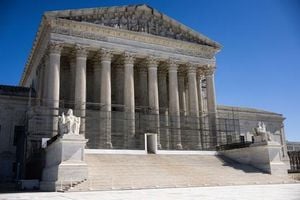The tranquility of the Patapsco River was shattered early on March 26, 2024, when the Francis Scott Key Bridge in Baltimore collapsed, sending vehicles and workers plummeting into the cold waters below. This catastrophic event unfolded as the Singapore-flagged cargo ship Dali, which had lost power just minutes before the collision, struck one of the bridge's support pillars at around 1:30 a.m. local time.
Authorities quickly recognized the gravity of the situation as they scrambled to respond to the dire emergency. Two members of a construction crew working to repair potholes on the bridge managed to survive, with one needing medical attention but later discharged, while unfortunately, six others were unaccounted for and presumed dead.
In the aftermath, local and federal officials grappled with the scale of the disaster, which not only disrupted lives but also halted operations at one of the United States' busiest ports. The impact was palpable, with President Biden promising that the federal government would cover all costs associated with the rebuilding of the bridge.
Situated approximately 1.6 miles long and spanning the Patapsco River, the Francis Scott Key Bridge has served as a critical roadway in Baltimore since its opening in 1977. The bridge was an integral part of Interstate 695, also known as the Baltimore Beltway, carrying an estimated 11.5 million vehicles a year. The immediate closure of its thoroughfare has set off a ripple effect of traffic woes across the city, with authorities declaring a major traffic alert.
The Dali had embarked from Baltimore's Seagirt Marine Terminal earlier that night, bound for Colombo, Sri Lanka, and initially seemed to navigate smoothly along its route. However, at precisely 1:25 a.m., the Dali's trajectory changed dramatically as it lost propulsion and subsequently veered off course, resulting in the tragic collision. Video from the scene shows the Dali, which weighed an astonishing 213 million pounds, accelerating and losing its lights before it struck the bridge.
Maryland Governor Wes Moore credited the crucial mayday signal sent from the Dali as a saving grace that allowed first responders to halt traffic just moments before disaster struck, effectively saving many lives.
As investigations began, first responders transitioned from rescue to recovery mode amid challenging conditions. Sonar technology detected multiple vehicles submerged in the frigid waters of the Patapsco, complicating efforts due to hazardous debris and rapidly changing currents. Divers commenced recovery operations in the days following the collapse, aiming to bring closure to the families affected.
The Maryland State Police confirmed that some of the missing workers included individuals from Guatemala and Honduras, prompting an outpouring of support from their respective embassies. These workers were identified as essential members of the local workforce, highlighting the personal toll this disaster took on many families.
The ship's operators, Synergy Marine Group, and its charterers, Maersk, were thrust into the spotlight as scrutiny regarding the Dali’s operational safety intensified. Initial investigations revealed that the ship had experienced multiple electrical blackouts preceding the tragedy, with the National Transportation Safety Board (NTSB) examining whether prior warning signs had been ignored.
The timeline leading to the bridge's collapse raises significant questions about safety procedures within the maritime industry. The preliminary NTSB report indicated that the Dali had suffered blackouts the day before the collision while still docked in Baltimore, which suggests potential negligence on the part of the crew or the ship’s management.
Additionally, scrutiny escalated surrounding the minimal protective measures at the bridge itself. Although the bridge had been designed with some protective barriers, these proved inadequate in preventing the Dali from causing catastrophic damage, leading officials to rethink safety standards at other bridges across the region.
The economic ramifications of the bridge collapse extend far beyond Baltimore. The port's closure has resulted in significant disruptions to supply chains across the East Coast. Experts predict that thousands of containers will need to be rerouted through alternative ports for the foreseeable future, creating a bottleneck in logistics that could ripple across various sectors.
The losses incurred may also lead to litigation against the ship's owners, as civil suits are already emerging. With recovery efforts ongoing, the focus shifts to ensuring that proper safety measures are put in place to prevent such calamities from occurring again.
Amidst this crisis, the story of the bridge workers who lost their lives serves as a sobering reminder of the risks involved in infrastructural maintenance. Leaders and citizens alike express their condolences, while advocates for workplace safety demand stringent regulations to ensure the protection of workers engaged in similar operations nationwide.
As authorities continue to piece together the full events leading to the bridge's collapse, the impact of this incident will be felt for years to come, both in the lives of those directly affected and in the broader context of transportation safety and economic continuity in the region.



